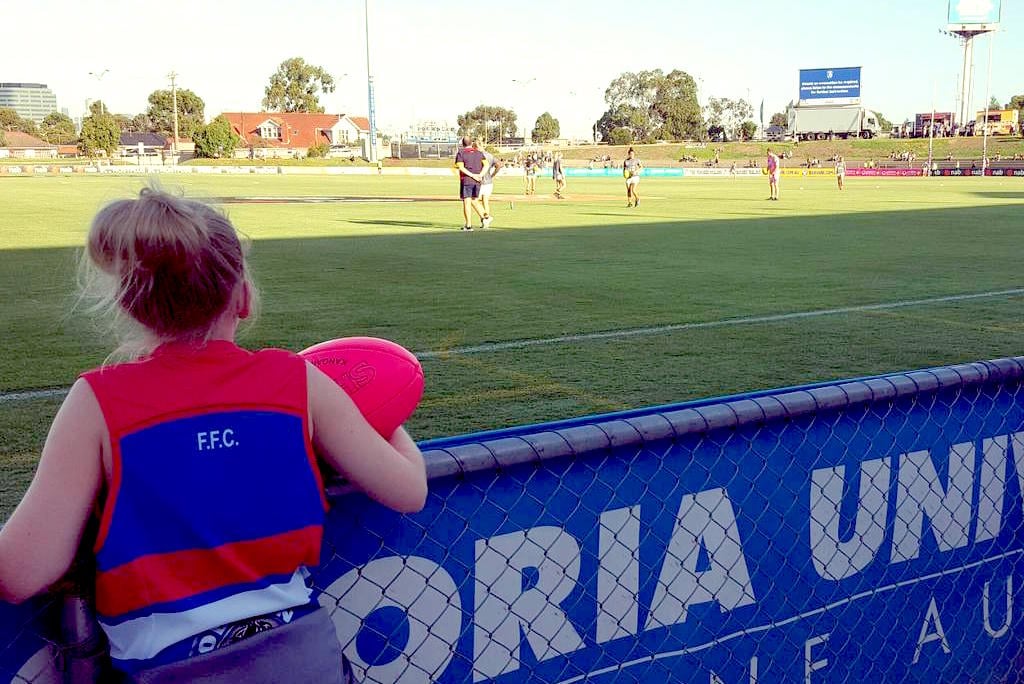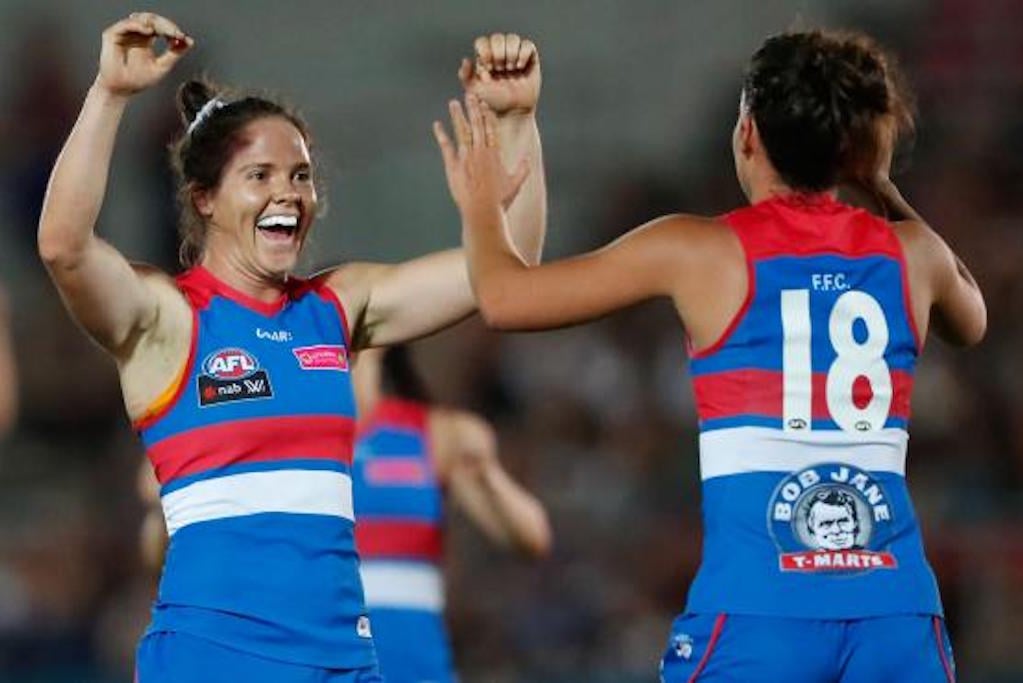How The AFLW Is Bringing Aussie Rules Back To Its Roots
"It feels a long way from the Southern Stand of the MCG, in the best possible way."

I went to my first game of Aussie Rules when I was six-weeks-old. My Dad took me to see North Gambier play in the Western Border Football League, a regional competition for the area that covers the southern border between South Australia and Victoria. In a region renowned for its high rainfall, supporters would drive their cars up to the boundary line and beep their horns to make their feelings heard.
Many of my favourite childhood memories come from watching Glenelg play in the South Australian National Football League (SANFL) with my dad and grandpa after we moved to Adelaide. On Thursday nights we’d meet Grandpa and his friends for a drink and watch the boys train. On match days we’d get to the ground early to watch the reserves play before the main event. I’d climb up the concrete steps and mark the scores in the Footy Record. You could go down onto the ground at quarter and three-quarter time and listen to the coach address the huddle. At the end of the game you could run onto the ground and have a kick.
These days I watch my beleaguered Richmond Tigers play from the cheap seats of the MCG. We sit behind fences lit with neon-bright advertisements, lined with camera operators and security guards. The screens flash between the goals. There are score-reviews, there is pre-game entertainment, there are brand activations in the breaks. Our attention is constantly pulled away from the game itself.
I still adore Aussie Rules. I love the pace, the aggression, the showmanship. I love that going to the football feels like I’m spending time with my family, even though we don’t live in the same state as each other. I love that I’m following a tradition that has been in my family for generations, and that when I look around I am surrounded by others doing the same. I love that from the moment the first ball is bounced nothing else in the world matters. I regularly sit in crowds of up to 80,000 people from all walks of life and for the duration of the game it doesn’t matter where you’re from or who you vote for or what is happening outside of the ground. All that matters is the game.
A New Beginning
The AFL is a corporation — one that relies on broadcasting rights and ratings, sponsorship and advertising revenue. In recent years the demand for this revenue has seen a spike in cooperation with the gambling industry. We now regularly see pre-match discussion of odds on television coverage, advertising at the game, and embedded coverage of odds in game fixtures, news coverage and through football news apps.
In the last week two prominent AFL players have come out publicly to question the invasiveness of gambling within the sport. They fear the impact the normalisation of gambling will have on children watching the game. When so much work has been done to remove tobacco and alcohol advertising from sports, it feels like gambling is the next frontier. But the reality is that the AFL is a commercial entity, and gambling organisations have made a strong play for the league’s attention. Sure you could argue that the revenue they bring has also funded the expansion of the league, and of community engagement and social programs, but at what cost?
Gambling advertising is out of control and I think it needs to change – let me know if you agree pic.twitter.com/zPTrC7OnFG
— Easton Wood (@easton_wood) February 10, 2017
When the AFL finally announced that a women’s competition would begin in 2017, I was a little trepidatious. The players’ wages were pathetically low until the mild wage-rise granted in November, and half of that salary would have gone on the players paying for their own insurance. I was also initially disappointed to see the competition start so small. Richmond weren’t granted a license for the inaugural year — only eight of the 18 teams in the men’s competition are playing in 2017 (the AFL has its eyes on a 2019 expansion). After waiting so long for the women’s league to form, I was frustrated by the caution.
But since that historic first game of the AFLW I’ve been hooked. I’ve sat in the stands of Ikon Park three times and on the hill of the VU Whitten Oval twice. I’ve read dozens of match reports, listened to podcasts and interviews, followed players on Instagram and, of course, talked about it all at the pub. There have been freakish goals, hard hits, and deft skills. If you love the game of Aussie Rules, you can’t help but love this league.
But what has hit me most is the infectious joy this competition brings. I’ve been to the footy with friends who had never previously been to a game before. I’ve watched kids bang on the old steel signs on the boundary of the VU Whitten Oval like I haven’t seen since those SANFL grounds as a kid. I’ve seen a young girl sit on her mum’s knee on the train home learning the Bulldog Women’s names.
Going to those suburban ovals again, sitting amongst crowds who are there to support the game as much as any particular team, there is a noticeable lack of aggression between supporters. There are no police and security having to roam the aisles. Food and drinks are served from trestle tables under marquees. It feels a long way from the Southern Stand of the MCG, in the best possible way.
The AFLW has not been a novelty or experiment; it’s been a revival of real footy. Scrappy, hard fought games free from commercial saturation. Community ovals with old-fashioned turnstiles free from the wrath of barcodes and barricades. Small grounds where you’re close to the action, where you can hear the players call to each other from wherever you sit. In the stands sit squads from the Victorian Women’s Football League (VWFL) clubs like Diamond Creek and Darebin, watching their past teammates play and seeing their dreams come alive.
Free from the club loyalty of the men’s competition, I’ve fallen in love with players from across the league too. There is so much I love about my club, but the freedom that has come from watching the game without loyalty has made me see Aussie Rules in a whole new light. When I see Darcy Vescio run into the fifty, or watch Katie Brennan burst through a pack, or Cat Phillips kick a game-changing goal, I’m supporting the player more than anything else. The jumper almost doesn’t matter (that ‘almost’ is for you, Collingwood).
The Road Ahead
There is going to be growth in this league. The wages need to rise. With visibility of women playing the game, participation will grow. Given the audiences continue to blow away expectations, television coverage and ratings will continue increase. This is all important. Building the game to stand on equal footing is what pioneers like Chyloe Kurdas and Susan Alberti have been fighting for for decades. But what I hope isn’t lost amidst this is the infectiousness of the league as it currently stands.
By putting community back into the game, by stripping back the gloss and commerciality, the AFLW has hit on something that is bringing in new audiences. It feels like a game you can bring kids to and not worry about drunks in the crowd, about fights breaking out, about sexist and racist insults hurtling out from the stands. The players see themselves as role models and actually behave accordingly. And so far, the betting agencies are keeping their distance.
I expected the AFLW to ignite me as a feminist. Finally, a hard-fought win in a male-dominated sport and administration — a chance for girls growing up loving footy like I did to be able to play, and for them to see women play at the elite level and know it is something they could one day do too. But the best surprise of all is that AFLW has reignited my love of the game. By stripping back the commerciality and taking the sport back to the community, AFLW has taken Aussie Rules back to its purest form — a highly inclusive, accessible and enjoyable game.
How good is Ikon Park.
How good is footy. #BoundByBlue #AFLWBluesGiants pic.twitter.com/YfGHu24Z0c— Cristian Filippo (@C_Filippo23) February 11, 2017
I hope the AFLW continues to grow and thrive. I hope it bring new audiences to the game we love and fosters new players and improve conditions for these pioneering teams. But let’s hope it also helps to remind us all of what Aussie Rules used to be and can be again — a game. Not a brand, or a font for gambling or advertising. Just a really bloody great game, for everyone.
–
Feature image via AFL Victoria Female/Twitter.
–
Kylie Maslen is a writer from Adelaide. She tweets (very often about footy) at @kyliemaslen or you can see her work at kyliemaslen.com
